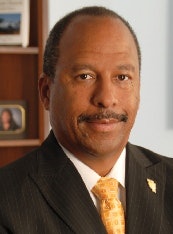 Thomas A. Parham
Thomas A. ParhamI read with interest the article by Eugene Parker titled Hire a Diversity Officer: Check! Parker is astute in his observation that many institutions are responding to the demands of students with the hiring of chief diversity officers. While it is difficult to accurately peek inside the mindsets of university presidential cabinet officials who huddle to make such decisions, it is painfully obvious that they appear to be challenged by several conceptual anchors or questions.
The first of these include: Do they really understand the difference between desegregation vs. integration and how these two constructs are operationalized on college campuses? Desegregation in essence is about the right to occupy the same geographic space. And whether we are talking about schools in 1954, buses in 1955, public accommodations and voting booths in the mid-60s, or universities in the late 1960s’ and early 70s’ days of affirmative action, each of these endeavors was perceived to be, whether right or wrong, about the right of oppressed people of color to occupy the same spaces as their White counterparts and enjoy the same privileges and opportunities. History reminds us, however, that changing the demographic composition did little to change the hostile climate many people of color experienced as they sought to take advantage of their newfound freedoms. The Black Lives Matter movement reminds us that, although our campuses are desegregated, students of color continue to experience what many perceive as hostile campus climates.
Higher education institutions would do well, however, to be reminded that true integration on the other hand demands not only that an institution be more diverse by virtue of race, ethnicity, gender, age, physical ability, religious affiliation and sexual orientation (e.g., hiring a chief diversity officer), but also that each person and culture that composes the institution’s demographic makeup should be able to see themselves prominently reflected in the fabric of the institution in meaningful ways. In addition, people should be free to access those opportunities without having their esteem assaulted or the sensibilities fractured by incidents of racial insensitivity. Students are clear that classroom environments are sometimes hostile, campus activities like fraternity and sorority theme parties are racially insensitive, and monuments to old men with suitcases full of racial baggage are symbols of hate that should no longer be tolerated.
A second and related question that comes to mind is: Do colleges and university senior administrators have a coherent definition of diversity that moves beyond demographics? Diversity is everyone’s job and not simply the responsibility of the designated diversity officer. Also, these officers do not control and/or substantially impact elements of the university where students have been demanding change (i.e., the admission of more diverse students; the recruitment of more diverse faculty, staff, and administration; more curriculum that is culturally based; and a change in the climate where acts of racism and racial and ethnic insensitivity are challenged more vigorously and those offenders are held more accountable.
Most diversity officers that I know do not control these segments of the institution even though he/she could work collaboratively with those that do. In this regard, I would invite higher education to look beyond the “demographic diversity” characterization and rather draw on the definition of diversity provided by Loden & Rosener in their text titled Workforce America. There, they argue persuasively that real diversity is less about demographics and more about a question of whether the policies and practices of an institution or agency changes as a result of the changes in the demographics. In this regard, what policy and practice is an institution prepared to modify to meet the contemporary demands of students whose protests are becoming more frequent?
A third question in need of addressing relates to whether colleges and universities are prepared to make real and substantial cultural shifts. Are they prepared to share influence and the power to control and manage decisions that shape the institution’s diversity initiatives? In essence, that understanding invites all of higher education to interrogate the question of whether institutional values, customs, and traditions need to change as well. This seems to be what students are demanding and will likely be among the metrics protestors will use to measure and assess diversity progress of not just diversity officers but the entire institution.
A final note is reserved as an invitation for institutions to explore and manage the within-group variability that exists among Black people and other people of color because there is a fundamental difference between skin color and consciousness. Hiring Black diversity officers, other staff and faculty is one thing, but ensuring they have the cultural consciousness to relate to the students is quite another. And, even if these individuals are culturally progressive, there is no guarantee that those faculty, staff, or administrators will be perceived as such by more radical elements of the student community whose litmus test for “who is Black enough” may stretch the boundaries of what these individuals and the institution agree are reasonable. The same challenges relate to increasing student diversity as well.
For example, responding to demands from students connected to an organization on campus is one thing, but what about those Black students whose relationship with the institution is more satisfying and who fundamentally disagree with the content domain and process dynamics of their organizationally affiliated peers whom they believe do not represent their interests well when negotiating with institution executives? How are institutions and chief diversity officers managing those circumstances?
Without question, the hiring and appointment of chief diversity officers is a step in the right direction. However, it is only one small element among a host of others that will be necessary to bring about real, substantial, and sustained change in higher education institutions across this country amid the protests that are gripping our campuses.
Thomas A. Parham, Ph.D is Vice Chancellor for Student Affairs at the University of California Irvine.





















